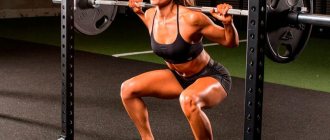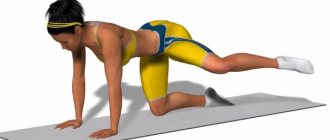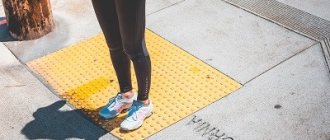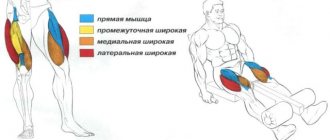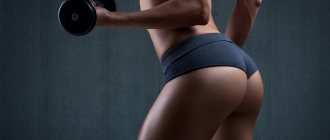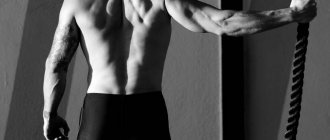Squats are one of the most effective exercises for giving volume and beautiful shape to the buttocks. You will learn how to squat correctly to pump up your gluteal muscles, and what additional exercises will help you gain beautiful shape. Knowing the structure, functions of muscles, and technique of performing exercises, you can easily achieve the desired elasticity and volume of the butt.
- Anatomical structure
- What are the benefits of squats? Is it possible to pump up your buttocks with squats?
- Classic with own weight
- Why don't my buttocks hurt after squats?
Anatomical structure
The gluteal muscles belong to the back surface and include: gluteus maximus, gluteus medius and minimus. The gluteus minimus is located under the gluteus maximus, which occupies most of the buttocks. The function of the gluteus maximus muscles is to straighten the torso, as well as move the legs back and to the side. The functions of small and medium ones are only to move the legs to the side. The gluteus maximus is, to a greater extent, included in the extension of the torso during exercises such as:
- squats with a barbell or dumbbells;
- lunges;
- Romanian deadlift;
- deadlift;
- bending over with a barbell on your shoulders.
The gluteus medius and minimus muscles work under the following loads:
- leg raises while sitting in a machine;
- standing leg abduction with a machine lever;
- swing your leg to the side from the lower block;
- swing your leg while lying on your side.
What are the benefits of squats?
This exercise uses a large number of muscle groups, improving physical fitness and strengthening the cardiovascular system. By doing squats, you can not only achieve beautiful shapes of the gluteal muscle, but also strengthen your back and abdominal muscles. Exercise provides pressure in the chest, which improves the respiratory system, saturating the body with more oxygen.
Is it possible to pump up your buttocks with squats?
Considering that the buttocks are involved in straightening the torso, squats are one of the best methods to pump up your butt well. And the lower the squats, the better the gluteal muscles work and the more effective the exercise is for elastic buttocks.
Important to remember! In order to make your buttocks strong, you need to lift weights. To do this, you need to perform an exercise to grow muscle mass, from 8 to 12 repetitions in one approach. Between approaches you need a rest of 1 - 2 minutes. The weight of the load should be heavy enough so that you do not have enough strength to perform more than 12 repetitions, this is the effectiveness of the exercise. But it’s better to start mastering the technique with light weights, gradually adding load each workout.
Technique for performing squats with a barbell
- Place the bar in a special power frame at shoulder level. Approach the bar with your back, placing the bar on the upper part of the trapezius, in no case do not place the weight on the cervical vertebrae;
- After removing the barbell from the racks, take a couple of steps back, placing your feet pelvis-width apart. Socks are parallel to each other, or slightly apart. The chin is slightly raised so that you can look up;
- Inhale: slowly squat, lowering your hips horizontally. The knees form an angle of 90 degrees, and the knees should not go beyond the toes, as this will injure the knee joint. The gaze is directed upward, the back is straight, the shoulder blades are brought together. Elbows point slightly back.
Remember! The lower back is not rounded and the body does not lean forward too much. We stretch our tailbone back - this is mandatory when performing the technique for the growth of the gluteal muscles, this increases the stretching of the muscle.
- Exhale: using more force from the gluteal muscles, we perform a faster rise, straightening the knees and straightening the torso. When returning to the starting position, it is advisable not to straighten your knees completely in order to relieve the load on your knees.
Squat complex
Exercises should be performed daily, repeating each exercise 15-20 times. Then, when it is no longer difficult to do such a complex, increase the load or add additional weight.
Exercises without weight
A regular squat will help strengthen your buttocks and improve the overall condition of your leg muscles. Carry out it, keeping in mind all the rules and nuances listed above. Stand straight with your feet slightly wider than shoulder-width apart. As you inhale, do a squat, and as you exhale, straighten your knees.
Plie will pump up the gluteal muscle, external and internal thigh muscles. To perform this exercise, stand straight with your feet slightly wider than shoulder-width apart. The feet are turned to the sides. Inhale and lower yourself down; as you exhale, return to the starting position. Try not to stick out your buttocks.
Combine squats with body wraps and anti-cellulite massage.
If the gluteus maximus muscle needs to be worked, do the movement with a narrow foot stance. Bring your legs together and do a normal squat. The exercise may seem difficult at first, but over time it will not be difficult to perform.
The Curtsy exercise tones the gluteal muscles. Cross your legs. As you inhale, move your pelvis back, bending your legs to a right angle at the knees. Shift your weight to your front foot. The second leg does not touch the floor with the heel. As you exhale, return to the starting position.
The “Balance” movement will give increased load on the buttocks. Place your feet hip-width apart. Lift the heel of your right foot up. As you inhale, do a squat, transferring your weight to your left foot. Return to the starting position and repeat, switching legs.
“Swallow” is an advanced exercise that will significantly increase the load on the buttocks, back of the thighs, and back muscles. Holding the chair with your hands, stand on one leg. The second is laid forward and bent at the knee. Try to keep it suspended. Perform a squat while inhaling, moving your body forward and your free leg back. As you exhale, return to the starting position.
Squats with additional load
At home, it is better to take dumbbells as an additional load. This weight will not put additional stress on the spine, but will help increase the effectiveness of the exercise.
Place your feet shoulder-width apart (or slightly narrower, at pelvic level). Take dumbbells of a suitable weight in your hands. Start with light weights and gradually increase it. Perform a normal squat, trying to get your hips as low as possible. If your arms are down, lightly touch the dumbbells to the floor at the bottom of the squat. Do not lift your heels, otherwise the load will be distributed incorrectly.
The weight of the barbell will be selected by the instructor at the fitness club.
Squats with a barbell should only be done with good physical fitness and under the supervision of an instructor. This is a high-impact exercise that will help you build muscle mass effectively.
Types of squats for the buttocks at home, to quickly increase your butt
Below you will find tips and recommendations on how to squat correctly to pump up a girl’s buttocks without the help of a trainer, even at home without exercise equipment. We have described the technique for performing each
Classic with own weight
The exercise primarily works the gluteus maximus, quadriceps femoris, and adductor muscles. When working with your own weight, the lumbar extensor and core are less loaded. Squats are the most important and difficult exercise in physical culture, so the body must be well prepared for it. You can do bodyweight squats right away by practicing proper technique, even if you're a beginner. But for proper preparation, you need to tone all the muscles, then after a while, you can move on to squats with a barbell. Therefore, bodyweight squats are good for understanding technique and toning muscles, but you won’t be able to build curves this way.
Deep
Deep squats, where the pelvis drops below parallel to the floor, forming an acute angle at the knees, best load the gluteus maximus and gluteus medius muscles. Also, during the load, the quadriceps, lower back, abs, and adductor muscles of the thigh are involved. It is a deep squat that can put more load on the buttocks, since they are the first to engage when the torso straightens. The range of movement also increases, which provides greater tension and effort in the muscles. To grow the buttocks, it is recommended to squat deeper than with the classic version. The exercise is performed provided that the ankles are flexible enough, otherwise a deep squat will not be possible due to the peculiarities of physiology.
With a narrow stance
This placement of the feet is set shoulder width apart, not too close, this will ensure a stable body position. The following muscles are involved: quadriceps femoris, gluteus maximus and medius, adductors, lower back and abdominal muscles. In this option, the gluteal muscles are optimally worked out. But it is necessary to take into account morphological features: length of the thigh, flexibility of the ankles, ligaments, length of the body. With individual characteristics, it can be difficult to implement this option. Therefore, you can place your feet a little wider, parallel, or slightly turn your toes out. Then the position will be more stable and the muscles will be properly loaded. The main thing is to squat until your thighs are horizontal.
Sumo
Sumo or wide squats include the gluteus maximus and medius, quadriceps femoris, adductor major and longus, and gracilis muscles. The wide position of the feet in this version provides a load on the adductor muscles of the thigh, working these groups more strongly than classic squats. This exercise should be part of a set of exercises, but should not be the only one and often repeated, as it noticeably increases the shape of the inner thigh.
Curtsy
The exercise is also known as cross lunges. The main part of the load is taken on by the gluteus maximus and medius, and the quadriceps muscles of the thigh. Additionally: hamstrings, abs, back, semitendinosus and semimembranosus muscles. Lunges are a great addition to squats in a leg program, and there are many variations of this exercise. An important condition for carrying out such a load is flexible joints. The exercise stretches the gluteal muscle well.
With dumbbells or kettlebell
The technique of squats with dumbbells remains the same as in classic squats with a barbell; the same muscles work. But the advantage of the exercise is that it does not subject the spine to compression. Vertebral injuries, displacements, osteochondrosis, intervertebral hernias are a contraindication to squats with weights on the shoulders. Therefore, this type of load will be a good alternative to a barbell.
Plie
An exercise with widely spread feet, similar to the ballet “Plie” technique, trains the gluteus maximus and gluteus medius, a group of adductor muscles of the thigh. The auxiliary muscles are: quadriceps femoris, lower leg, abdominal muscles. When performing this exercise, sufficient flexibility of the hip joint is necessary. The good thing about this exercise is that it doesn’t overload the quadriceps. But to grow the buttocks, you need an optimal load weight; you need to ensure concentrated movement through the gluteal muscles, without overloading the adductor hips.
Deep on one leg
The advantage of the pistol exercise is that it develops muscles well by working with your own weight. The exercise does not require additional equipment. But it is not so easy to learn, and a sufficiently trained person can perform it. The exercise works the quadriceps and gluteus maximus muscles. Only for the knee joints the exercise is quite traumatic. The acute angle of the knee receives a lot of stress and this is a contraindication for any problems and pain in the knees.
With a barbell
Working with free weights, especially squats with proper technique, is the best assistant for elasticity and growth of the gluteal muscles. An exercise in which the muscles perform a stabilizing function, providing balance, trains beautiful forms faster and better. Contraindications to training with a barbell: injuries and diseases of the spine.
In the Smith machine for beautiful buttocks
The Smith Squat Machine is a great alternative to barbell squats, but it won't last forever. To adapt the muscles to the load, while the muscle corset has not yet formed and the technique with the barbell is still complex, it is quite advisable to perform squats in a Smith machine. Support on the bar, a stable position of the body and knees will ensure the correct load on the butt and quadriceps of the thigh. You can perform the squat technique with different foot positions.
The best types of squats
The classic version of squats is the simplest and most effective exercise. Its advantage is its versatility, since it is used by both trained athletes and beginners.
Technique:
- Take the starting position - standing on the floor with your feet apart, shoulder-width apart.
- Straighten your arms and raise them parallel to the floor.
- Squat down slowly so that your thighs are parallel to the floor.
It is important to watch your back and avoid arching or rounding, or tilting or lifting your head. During the exercise, your knees should be positioned above your feet, and your heels should be on the floor and not lifted off.
You need to perform 3 approaches, each 10 times. For trained people and those who want to achieve results faster, it is allowed to add 10 times to each approach.
Narrow
The exercise is performed similarly to the previous one, but the lower limbs are not spread shoulder-width apart, but joined together. This option is more suitable for girls who want to pump up not only their buttocks, but also their legs, since it creates additional tension in the muscles of the front of the thigh.
The number of repetitions depends on training and ranges from 30 to 100, divided into 3 approaches. When doing this, it is important to monitor the position of your feet and not lift your heels off the floor.
Wide
The exercise is performed in the same way as the previous one, but the legs are spread wider than the shoulders. This allows you to maximally work the gluteal muscles and inner thighs. During a squat, your arms can be straightened in front of you parallel to the floor or clasped at chest level.
You should perform at least 40 repetitions, divided into 4 sets. For trained people, up to 100 repetitions are allowed. The position of the back, head and heels is unchanged, as in the previous versions.
Plie
A simple but effective exercise for pumping up the gluteal muscles. Performed with or without support, depending on the level of preparedness.
Technique:
- Take the starting position - standing on the floor with your feet apart, shoulder-width apart.
- Spread your legs as wide as possible.
- Spread your knees apart from each other.
- Squat, bending your knees as much as possible so that your thighs are parallel to the floor.
It is important to monitor the position of your back: it should be straight; the eyes look straight, the body does not bend, the heels do not leave the floor. You are allowed to hold on to a chair or bar with one hand, keep your hands parallel to the floor or clasp them together at chest level.
You need to perform from 20 to 50 repetitions, depending on your level of training.
Girls who want to achieve results in a week are recommended to include this type of squats in their daily routine.
"Pistol"
A slightly more complicated version of squats on one leg with the goal of maximizing pumping of the gluteal muscles.
Technique:
- Take the starting position - standing with your legs connected, your legs locked at chest level.
- Raise one leg straight.
- Squat on the other leg until your thigh is parallel to the floor.
Repeat for each leg at least 20 times. It is better for beginners not to start with this option: it is more suitable for those who want to achieve quick results in a week or month, but already have experience in such training.
Deep on one leg
The exercise is similar to the previous one, but squats must be performed until the gluteal muscle rests on the shin. This option is quite complex and is suitable only for trained girls who have already mastered the “Pistol” and do not feel much stress when performing it.
10-15 repetitions for each limb are enough to achieve noticeable results after just a month of regular training.
Bulgarian
This type is suitable for those who want to achieve quick results. It is performed with some complications and separately for each leg.
Technique:
- Stand next to a platform or bench no more than 50 cm high.
- Turn your back to her and place your foot on your leg bent at the knee.
- On the second, squat until your thigh is parallel to the floor.
Repeat for each limb at least 20 times. Trained girls are allowed to use weights up to 2 kg in each hand in order to increase the load on the muscles.
With a barbell
Such exercises are suitable only for trained women and girls. It is recommended to perform them at first under the supervision of a trainer, so that he can correct the technique and point out weak points.
The weight of the weights on the bar should not exceed 4 kg on each side. It can be placed on the shoulders, supported by arms bent at the elbows, or on the chest, pressing firmly to the area just below the collarbones.
The technique is no different from classic squats, but you need to monitor your back position more carefully, since using weight increases the risk of injury. The number of repetitions depends on the level of training and ranges from 20 to 50 per lesson.
With dumbbells or kettlebell
This version of squats is also performed using the classic technique, but the arms are not raised in front of you. In them, you should take a kettlebell or dumbbell weighing 5 kg and hold it between your legs while doing squats.
The number of repetitions depends on the level of preparedness and is 30-60 times, divided into 3 approaches. Beginners should not start with a lot of weight - a 2 kg weight is enough.
In Smith's car
The Smith machine is a special machine in which you can perform squats with a barbell by adjusting the weight. This type is performed only in the gym.
This exercise is not recommended for beginners, as it creates stress not only on the gluteal muscles, but also on the back, which often causes injury. But if the girl nevertheless chooses this option, at first it is better to refuse weighting.
For trained athletes, 30-50 repetitions are enough to achieve results. The weight is adjusted independently, taking into account preparedness and sensations during training. Girls are not recommended to exceed the 4 kg mark for each side of the barbell.
Lunges
Exercises with lunges are effective for pumping up the gluteal muscles and forming a beautiful relief. The most effective lunges will be forward and sideways:
- Forward lunges are performed from a standing position. The leg should be put forward, bent at the knee so that the thigh is parallel to the floor. The second leg from behind is straightened or touches the floor with the knee. To increase the load, you are allowed to pick up dumbbells, each weighing no more than 2 kg.
- Side lunges are performed similarly, but the squat on the leg should be deeper, and the second limb should be straightened and placed on the foot. In this option, it is also allowed to use weights up to 2 kg in each hand.
The number of repetitions ranges from 10 to 20 for each leg. For trained girls, up to 30 repetitions are allowed.
Exercises with increasing load
To increase the effectiveness of training, it is recommended to increase the load and combine squats with several load options in one session:
- 10 classic squats with a 1 kg load in each hand.
- 15 squats with narrow legs and a 1.5 kg load in each hand.
- 20 squats with wide legs and 2 kg dumbbells.
This approach to training will allow you to achieve significant results in a week. If you stick to this program for a month and train every other day, the effectiveness increases even more.
You should start such exercises only after mastering all types of squats without weights. Those who have not exercised before are advised to postpone this program to avoid excessive muscle strain.
If during training you experience pain in the lower back or another part of the body, you should stop exercising and seek help from a specialist.
A set of squats for buttocks for 30 days
Attention : Each approach increases the weight of the load, decreases the number of repetitions.
Table of exercises performed by week for a month.
| Approach 1 | Approach 2 | Approach 3 | Approach 4 | |
| 1 Week | 20 | 15 | 12 | 12 |
| 2 week | 15 | 12 | 10 | 10 |
| 3 week | 12 | 10 | 10 | 8 |
| 4 week | 12 | 10 | 8 | 8 – 6 |
What exercises need to be added to maximally work the gluteal muscles?
In addition to basic exercises for buttock growth, the program must include auxiliary exercises that will ensure comprehensive muscle development. You can’t do without exercises such as:
- deadlift on straight or bent legs;
- bending over with a barbell on your shoulders, standing or sitting;
- swing your leg backwards in the simulator;
- gluteal bridge;
- swing your leg up, resting on your forearm;
- hyperextension;
- leg raises in the simulator.
Why don't my buttocks hurt after squats?
During physical activity, the muscles experience tension, which causes micro-tearing of the muscle fibers. If the muscles are not prepared, they usually hurt the next day. It's not a matter of lactate, lactic acid, which gets into the fiber gap and causes pain in the form of sore throat. The point is the fiber injury itself. The lactate stops after 2 - 4 hours, and the muscles hurt for several days. It's a matter of trauma. Pain caused by a rupture is not an indicator of a good and correct load. And the absence of pain is not an indicator of ineffective exercise. A prepared body that exercises regularly begins to experience less discomfort such as sore throat. This means that the body gets used to the load, and you can gradually add weight, but without fanaticism.
What should you do to avoid injury?
The first thing a workout begins with is a warm-up; warming up the muscles and ligaments will reduce the risk of injuries in the form of sprains and ruptures. Also, the technique of execution is important, this will save you from excessive stress on the joints and spine.
What weight to start with and how to increase it correctly?
It is better to perform squats with your own weight, having mastered the correct squatting technique, preferably under the supervision of a trainer, you can gradually add load. Then you can take the empty bar on your shoulders; if the body does not fall forward and the knees remain motionless, feel free to add weight. But provided that you lift with this weight. It is advisable to add no more than 5 kg, and then not every workout. If you easily completed the exercise for 12 repetitions, feel free to add load, even if you can complete 10 repetitions.
How long does it take to build beautiful buttocks with squats?
With constant load and proper rest, muscles grow depending on the constitution of the body. The result will not appear immediately; it requires constant and hard work. Everything will be individual for everyone, you can see the result in 3 to 6 months. But personal preferences also play a role; some need to gain 3 cm in volume, while others need as much as 10 cm. Accordingly, it will take more time.
Exercises at home
From the whole variety of complex exercises, you can independently choose the appropriate program. Training should take into account physical parameters, level of training, and endurance. There are many options for practicing at home.
See also
List of hormonal drugs for breast growth in women and how to take them
Classic
Before starting the class, you should master the basics, so you need to start with classic squats. This will help you understand the technique, determine your strengths and capabilities, and form the optimal number of repetitions and approaches. Before training, you need to familiarize yourself with some rules:
- During the entire process, the back is arched and the shoulder blades are retracted to minimize the risk of injury to the vertebra. You need to press your heels into the floor as much as possible, without lifting them under any circumstances.
- During a squat, your knees are shoulder-width apart. A large distance between the legs will help pump up the legs and thighs, not the buttocks. The head is kept straight, without lowering or lifting it.
- The barbell is placed on the trapezius muscles, when the shoulder blades are brought together. The weight should not be placed on the neck - this can lead to injury. When lifting, you do not need to straighten 100%, this will increase the load on your knees.
Beginners are not recommended to squat deeply, otherwise there is a high probability of knee injury. After regular classical training, you can approach deep squats, since by this time the knees have developed and are prepared for the load.
Deep
With deep squats, the buttocks are loaded more, the muscles are stretched. The training follows the following rules:
- the position of the feet should be wider than the shoulders, toes pointed to the sides;
- exhaling, the pelvis is lowered below the knees;
- when exhaling, push off with the heels, straighten, straining the gluteal muscles.
You need to do the exercise 10-15 times in 3-4 approaches. If you wish, you can take a dumbbell or barbell to make the load heavier.
With a narrow stance
When the legs are positioned narrowly, the gluteal and quadriceps muscles are activated. The back is straightened, the feet are brought close, the arms are lowered along the body, and squats according to the standard method.
During regular exercises, fat accumulations are removed and the outer and inner thighs are strengthened. The pattern is similar to classic squats, only the legs are brought as close as possible.
Sumo
In addition to the buttocks, the adductors, quadriceps femoral muscles, abdominal and back muscles are included. The exercise occurs sequentially:
- The position of the feet should be wide, with the toes turned to the sides. A bar is placed on the trapezius muscles.
- Inhaling, move the pelvis back, controlling the position of the knees. They should be turned out to the sides, parallel to the toes.
- Exhaling, knees straighten and rise.
The sumo bar should be light, since the load is intended for weak adductor muscles. Squats are repeated 10-15 times, 2-3 approaches.
Curtsy
Cross lunges work the butt muscles. The technique is similar to a curtsy, while the muscles of the buttocks are stretched and strengthened. When using a dumbbell or barbell, the shape of the buttocks will become rounded and toned, they will visually rise.
Proper technique requires flexibility in the joints, so an intensive warm-up will be required before this exercise. During the lesson, the gluteal, femoral, quadriceps, semitendinosus, and semimembranosus muscles are activated. Stabilization of the torso is ensured by the correct inclination of the abs and back. The exercise is done this way:
- The legs are placed wider than the pelvis, with the toes spread apart. The knees should not curl during the squat. The weight from one leg is transferred to the other in a diagonal position. The legs are positioned in a cross, with the toes of the rear foot facing the inside.
- Sit down, the knee of the front leg bends until the thigh is parallel to the surface. The knees should not go beyond the toes, the load rests on the heels.
- The supporting leg reaches behind the front leg, but it is important not to touch the floor. During a squat, the gluteal muscles are stretched. The torso must be slowly straightened.
At the next stage, the exercise is repeated or replaced with another.
With a kettlebell or dumbbells
During the lesson, the gluteus maximus, gluteus medius, and femoral quadriceps muscles are loaded, which includes the rectus, vastus lateralis and vastus intermedius muscles. The exercise is done this way:
- with your feet parallel to your shoulders, take dumbbells;
- inhaling, the pelvis is gradually lowered, while the thighs should be parallel to the surface;
- your knees should be kept straight and should not go beyond your toes;
- the body should not collapse, the back should be kept straight, the head straight;
- while exhaling, push off slightly, unbend, straighten your knees.
See also
Excessive sweating: effective folk remedies
The exercise is carried out 10-12 times in 3 approaches, paying special attention to the fifth point. The load should be moderate, especially if you have problems with the spine.
Plie
The method of squats is similar to ballet techniques. In the process, there is a load on the adductor femoral, medius, gluteus maximus, quadriceps, abdominal muscles, and shins. To perform a plie, you will need flexibility in the hip joint.
The advantage of the workout is that there is no overload on the quadriceps. An increase in butt volume occurs due to the correct squatting technique. You need to go down and up, loading not your legs, but your buttocks. The plie technique is simple:
- They stand up straight and bend their back. The legs are placed parallel to the shoulders, the socks are spread to the sides.
- Taking a deep breath, squat, exhaling, straighten your knees, and rise.
This exercise tightens the gluteal and thigh muscles. The exercise is effective for problem areas such as the inner thighs.
Pistol
The workout is unusual because the squat takes place on one leg. During the lesson, the quadriceps is strengthened, coordination and balance are improved, the muscle mass, leg muscles, and butts are activated. You can perform squats at home without the use of additional equipment:
- The legs are placed parallel to the shoulders, the weight of the body is transferred to one leg, the other is extended straight, and slowly lowered. Your arms should be extended forward - this will improve your balance. The hip joint should move back, the torso should be tilted.
- The back should be straight. The leg is raised at the same time as it is lowered. The non-working leg should be parallel to the floor.
- The hip and gluteal muscles should be as tense as possible. Without sudden movements, you should push off, rise and straighten your knee. The same is repeated with the second leg.
The pistol squat is a difficult squat to coordinate and requires good flexibility and elasticity. The hip, knee, and ankle joints receive greater load.
